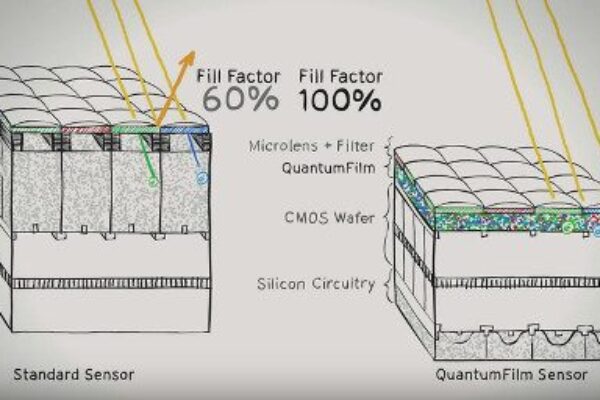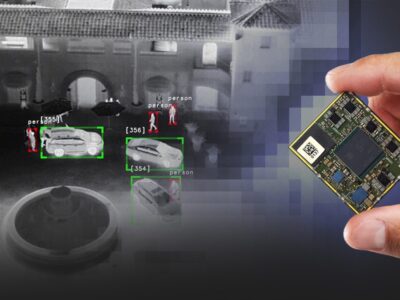
The company is shooting for the smartphone market to begin with but claims it has the beating of CMOS image sensors in terms of many specifications and therefore in most of if not all applications.
InVisage Technologies Inc. (Menlo Park, Calif.), was founded in 2006 to develop a light-sensitive material to replace silicon. On Nov. 11 in Beijing, the company launched the world’s first electronic image sensor that uses quantum-dot material rather than silicon to capture light.
If quantum-dot based light sensing is superior to that of silicon photodiodes – to the degree that InVisage claims – this could represent the beginning of the end for CMOS image sensors which have built up a considerable market on the strength of camera sales into mobile phones. InVisage claims that its Quantum13 sensor will drive “silicon image sensors into obsolescence.”
At a launch event in Beijing the company demonstrated the ‘Quantum13’ sensor designed into prototype smartphones. Although InVisage declined to name the smartphone firms involved, Jess Lee, company CEO, told eeNews Europe that the Quantum13 is sampling now and multiple customers are due to receive commercial volume supply in 4Q15.
The quantum-dot material is a II-VI metal-chalcogenide type broadband light absorber, Lee said. And with the quantum confinement produced by using nanoscale particles of the material bound together in an optically transparent carrier material, it becomes a highly efficient photodiode and allows thinner films than the active depth in conventional silicon photodiodes. Only about 0.5-micron depth of QuantumFilm is required compared with 2 or 3 microns depth of silicon photodiode, Lee said.
As a result the Quantum13 embodies a number of advantages over silicon. The 13Mpixel 1.1-micron pixel fits in 8.5mm by 8.5mm module. Light absorption takes place eight times faster than in silicon allowing for the use of a global electronic shutter. Using 0.5-micron thin films – rather than the high aspect ratio wells used for silicon photodiodes – allows much higher incident angles of light, resulting in 4mm camera height module. And thinner camera module allows for thinner smartphone designs.
Next: Video
About the making of Prix: the first video shot on QuantumFilm. Source: InVisage.
Quantum13 also has a single-shot high dynamic range (HDR) mode called QuantumCinema that provides up to three additional stops of dynamic range compared to conventional CMOS image sensors, according to InVisage. Quantum13’s global shutter, is the first offered for smartphones, and enables full frame capture instead of a rolling shutter method conventionally used in CMOS image sensors. This helps take crisp photographs of fast-moving subjects.
“The launch of Quantum13 marks a new era for the smartphone camera industry,” said Jess Lee, CEO of InVisage, in a statement. “For the first time, smartphones will capture images on an entirely new medium. Not silicon, not film, QuantumFilm.”
The CMOS image sensor market is said to be worth about $10 billion in 2015 and is expected to grow at a compound annual growth rate (CAGR) of 10.6 percent from 2014 to 2020, according to market research firm Yole Developpement.
The 13-megapixel camera sensor market is expected to increase from 408 million units in 2015 to 995 million units in 2020, according to Techno Systems Research.
TSMC provides initial wafer manufacturing and back-end interconnect. InVisage has its own manufacturing site in Hsinchu, Taiwan for laying down the metal-chalcogenide film and then sends wafers on to VisEra Technologies Co. Ltd., a TSMC affiliate, for color filter desposition. Thereafter the QuantumFilm sensors are sent on to conventional test and packaging houses.
Next: Compare and contrast


Next: QuantumFilm

Not quite as good as Kodak film but better than silicon? Source: Invisage
The company did not reveal how large a price premium it is asking for over 13Mpixel CMOS image sensors, but said that prices will depend on the volumes and the degree of partnership and co-engineering required.
InVisage has raise more than $110 million of venture capital since its formation and has appeared on multiple iterations of EE Times’ Silicon 60 list of emerging technology companies.
Related links and articles:
News articles:
InVisage, TSMC, join forces for image sensor attack
EE Times Silicon 60: 2015’s Startups to Watch
China VC lifts sensor startup to record funding
Quantum film startup raises $17 million in Series D
15-in-15: Analog, MEMS and sensor startups to watch in 2015
 If you enjoyed this article, you will like the following ones: don't miss them by subscribing to :
eeNews on Google News
If you enjoyed this article, you will like the following ones: don't miss them by subscribing to :
eeNews on Google News




